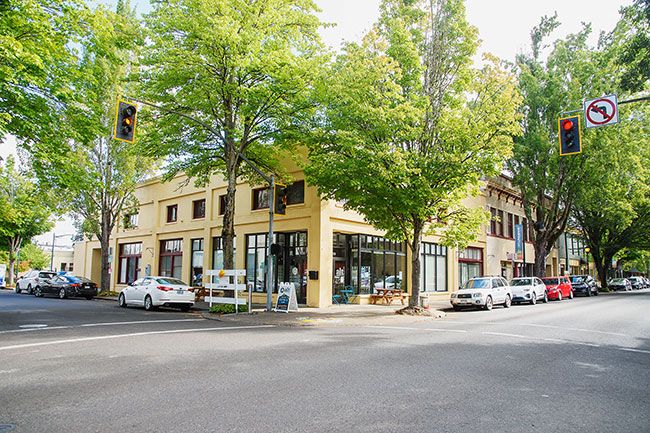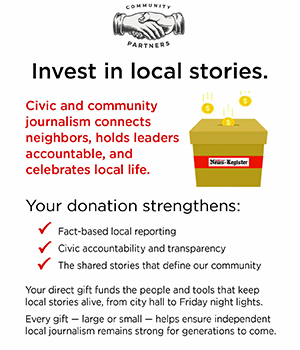Paddock: Rue the day aging buildings worth more dead than alive

You will find stunning eloquence in numerous submissions from the public defending our historic downtown. Check them out in Historic Landmarks Committee files, posted online.
This wasn’t always the sentiment. It’s taken time and dedication from the community to turn downtown around.
When I was growing up, utilitarian Main Street was for buying socks and undies at Penney’s. Nightlife was nearly nonexistent in a downtown utterly abandoned to teenagers Dragging the Gut.
Back in the ’90s, the Downtown Association joined the city in looking to improve downtown.
I seem to remember they wanted to add mid-block crosswalks, swap out the lighting and institute a color code. Apologies to those who worked so hard on all the items I left out.
I rolled my eyes at the color code and lamented the loss of the overarching cobra lamps for the imitation Dickens uprights. I hope they’re stashed in a warehouse somewhere pending their nostalgic return.
Preceding these measures, in the late 1980s, the city created the Downtown Historic District. It classified buildings on the basis of numerous characteristics, submitted the results to the National Register of Historic Places and succeeded in winning formal acknowledgement.
And the city was right. In conjunction with the burgeoning wine industry and awesome natural features of the Willamette Valley, its farsighted historic district, its bits of improvised history, and, yes, even its color code, have combined to make our downtown a terrific success.
We gentrified in ways that many of us liked. But now we’re becoming victims of that success.
The Gwendolyn proposal consists of two major parts — demolition of three historic buildings and construction of a large new hotel in their place. By definition, that tells us we are on the cusp of another downtown gentrification, whereby properties are worth more without their historic structures.
The proposed hotel misses the mark badly on massing.
The downtown design code requires that new construction appear to be two stories in height at intersections. The Gwendolyn succeeds in reducing its proposed six stories to five, visually.
To get around that, a waiver has been requested in which the applicants argue mightily for a three-story visual appearance. That is reasonable, given the context of the surrounding buildings, but their design fails to achieve that.
As it stands, we have a five-story visual appearance, which opens the door to structures large enough to negate the value of the existing historic structures around them. Paraphrasing a comment from one of the many public letter writers, “If a smaller building that follows the rules is not economically feasible, then maybe this is the wrong place for the hotel.”
Arguably, though, the bigger problem is the demolition portion of the project.
There is the very real cost to repairing, maintaining and upgrading historic structures, and the applicants argue it is prohibitive. But if big money-making projects can cause properties to be worth more demolished than refurbished, where is the incentive for an owner to perform even routine maintenance in the meantime, let alone earthquake reinforcements — especially if their lack increases property value?
Ultimately, the greater issue is not this specific project. It’s what its approval would mean for the downtown district overall.
Allowances and waivers made here will apply as precedent throughout the downtown core, potentially making every other structure more valuable dead than alive.
McMinnville faces a dilemma. If it hopes to save its historic downtown, it must find a way to help building owners refurbish them before their condition merits an economic argument for their removal.
Perhaps we’ve already reached that point. There’s a demolition criterion based on whether or not the existing buildings stand in the way of a particular program.
Perhaps the applicants, along with other stakeholders and members of the larger community, could propose and facilitate a genuine downtown economic program. It would include a re-evaluation of structural conditions in the district, suggested schedules for maintenance and improvement, strategies to increase existing loan and grant opportunities, and updated demolition criteria that would not sound a general death knell for historic structures.
Business titans used to give back to communities. Our historic Carnegie library comes from that tradition.
If the applicants really want their project to enhance historic downtown McMinnville, rather than provide a template for its demise, this is a way to start.
For now, the city’s demolition and design standards should hold off this project.
But to face the oncoming gentrification, we could use a new round of farsighted thinking and planning, like that of the ’80s and ’90s. Otherwise, time will continue to work on the buildings, and developers will wait for public interest to slip, codes to change and buildings to weaken until they get their way.
Carol Paddock was raised in the McMinnville/Lafayette area. She returned after studying music and architecture at the University of Oregon to take a job working in engineering and quality control at Cascade Steel. After taking time out to care for her mother, she is considering her options while serving as door attendant for her cats and little dog.













Comments
Bleepbloop
I'm struggling to have any empathy to the "don't build the hotel" argument. A) who decides those buildings are historic. They are ugly as sin and under utilized. They obviously don’t make economic sense to just remodel them. B) hotels don't make economic sense at 2-3 stories. Everyone agrees we have a hotel shortage. The developers didn't have to do underground parking but they are. They are keeping the architecture classic, not some glass and steel building. McMinnville is changing. With guardrails, that is a very good thing